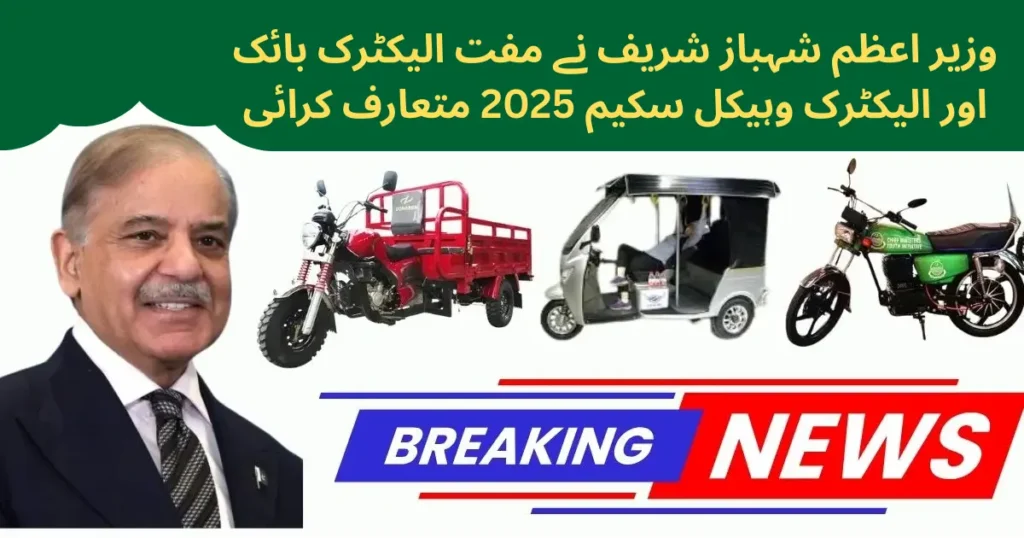
Pakistan is taking a bold step toward green transportation with the launch of Prime Minister Shehbaz Sharif’s Free Electric Bikes and Electric Vehicles Scheme 2025. Designed to benefit students, women, professionals, and low-income workers, this initiative marks a major turning point in how the country thinks about mobility. With a focus on affordability, climate action, and youth empowerment, the scheme has already generated nationwide excitement.
| Join WhatsApp | Click Here |
| More Govt Jobs | Click Here |
| International Job/Visa | Click Here |
| Make Money At Home | Click Here |
| Subscribe YouTube | Click Here |
| Click Here | |
| Click Here |
Contents
- 0.1 Vision Behind the Scheme
- 0.2 Key Highlights of the Scheme
- 0.3 Why Pakistan Needs Electric Mobility
- 0.4 Eligibility Criteria for the Scheme
- 0.5 Step-by-Step Application Process
- 0.6 Phased Distribution Plan
- 0.7 Financial Structure of the Scheme
- 0.8 Environmental Impact of EV Adoption
- 0.9 Economic Benefits of the Scheme
- 0.10 Social Benefits of the Program
- 0.11 Challenges Facing the EV Scheme
- 0.12 Government’s Roadmap for Sustainable Mobility
- 1
- 1.1 Global Comparisons and Lessons
- 1.2 Public Reactions and Market Expectations
- 1.3 Long-Term Outlook of Pakistan’s EV Policy
- 1.4 Conclusion
- 1.5 FAQs: Free Electric Bikes and Electric Vehicles Scheme
- 1.5.1 Who is eligible for free electric bikes under this scheme?
- 1.5.2 How can women benefit from this program?
- 1.5.3 Will there be enough charging stations?
- 1.5.4 What are the costs of maintaining electric bikes?
- 1.5.5 What is the future of EVs in Pakistan after 2025?
- 1.5.6 Related posts:
- 1.5.7 CM Punjab Flood Relief Package 1,000,000 Rs
- 1.5.8 CM Punjab Asaan Karobar Finance Scheme 2025 Phase 2
- 1.5.9 CM Punjab Asaan Karobar Finance Scheme 2025
Vision Behind the Scheme
For decades, Pakistan has relied heavily on oil imports, burdening the economy and polluting the air. PM Shehbaz Sharif envisions a future where clean, affordable, and eco-friendly transport is not just a luxury but a basic right. By introducing electric bikes and vehicles, the government hopes to:
- Reduce dependency on fuel imports.
- Create opportunities for students and workers.
- Combat climate change through cleaner transport.
Key Highlights of the Scheme
The scheme is ambitious but well-structured. Its highlights include:
- Free Electric Bikes for students, delivery riders, and health workers.
- Subsidized Electric Vehicles for professionals, entrepreneurs, and families.
- Priority Access for Women to promote independence and safe mobility.
- Special Quotas for rural communities to bridge the urban-rural divide.
Also Check: Electric Scooter and Rickshaw Scheme
Why Pakistan Needs Electric Mobility
Think about the rising petrol prices you’ve seen at fuel stations. For an average Pakistani family, fuel costs take up a huge chunk of income. That’s where EVs step in:
- Rising Fuel Costs: Petrol and diesel prices keep climbing. EVs cut daily commuting costs by half or more.
- Urban Pollution: Major cities like Lahore and Karachi are among the most polluted globally. EVs help clean the air.
- Oil Dependency: Pakistan spends billions on oil imports. Switching to EVs reduces this economic burden.
Eligibility Criteria for the Scheme
The government has laid out clear eligibility rules to ensure fairness:
- Students: Must show valid enrollment in a recognized institution.
- Workers: Delivery riders, small business workers, and health professionals.
- Women: Reserved quotas to ensure accessibility and empowerment.
- Rural Applicants: Allocations to improve rural transport.
Also Check: PM Fan Replacement Program
Step-by-Step Application Process
The process is digital-first, ensuring transparency:
- Register online via the official EV scheme portal.
- Upload Documents such as CNIC, student card, or employment proof.
- Verification Stage is handled by the government.
- Approval and Delivery—successful applicants are informed of collection points.
Phased Distribution Plan
Distribution will take place in stages:
- Phase 1 (Pilot): Lahore, Karachi, Islamabad, and Peshawar.
- Phase 2: Expansion to Faisalabad, Multan, Quetta, and secondary cities.
- Phase 3: Full nationwide rollout, including rural and remote areas.
By the end of 2025, thousands of students and families will benefit.
Also Check: CM Punjab Green Credit Program
Financial Structure of the Scheme
This is not just a freebie program, it’s a carefully structured investment.
- Government Budget: A special fund has been allocated.
- Public-Private Partnerships: Local EV manufacturers and banks are involved.
- International Donors: Climate-focused organizations are expected to support Pakistan’s green transition.
Environmental Impact of EV Adoption
One of the strongest benefits of the scheme is environmental. Imagine cities where the smog finally clears:
- Carbon Emissions: A major reduction in Pakistan’s carbon footprint.
- Air Quality: EVs don’t emit harmful gases, improving urban health.
- Climate Goals: Supports Pakistan’s commitments under the Paris Climate Accord.
Also Check: PM Electric Bike and Rickshaw Scheme
Economic Benefits of the Scheme
EVs bring money-saving and economic growth opportunities:
- Savings on Fuel: Families can save thousands annually.
- Boost to Industry: Local EV assembly plants will expand.
- Job Creation: Mechanics, charging station operators, and manufacturers will see new opportunities.
Social Benefits of the Program
The scheme is not just about saving money, it’s about empowering people:
- Students: Reliable transport means fewer dropouts and better academic performance.
- Women: Access to safe, independent mobility supports equality.
- Rural Areas: Improved connectivity enhances quality of life.
Challenges Facing the EV Scheme
Of course, the road ahead won’t be smooth. Key challenges include:
- Charging Infrastructure: Pakistan lacks a strong charging network.
- Maintenance Gaps: Limited technical expertise for EV repairs.
- Resistance: Fuel-based transport unions may oppose the shift.
Also Check: T-Cash Card Scheme
Government’s Roadmap for Sustainable Mobility
To tackle these hurdles, the government has announced:
- Nationwide charging stations in universities, workplaces, and on highways.
- Training Programs for EV mechanics.
- Subsidies for EV manufacturers to lower costs and boost local production.
Global Comparisons and Lessons
Other countries provide useful lessons:
- India: Subsidies helped millions adopt e-bikes.
- China: Built the world’s largest EV market by investing in infrastructure.
- Norway: Achieved global leadership with strong tax incentives.
Pakistan’s scheme borrows these ideas but adapts them for its unique challenges.
Also Check: Punjab Super Seeder Subsidy Scheme
Public Reactions and Market Expectations
Since the announcement, the response has been mixed but largely positive:
- Students: Excited for affordable transport solutions.
- Women: Appreciating special quotas for mobility.
- Transport Unions: Concerned about losing relevance.
Long-Term Outlook of Pakistan’s EV Policy
If executed well, this scheme could be the foundation of a green Pakistan:
- EVs could become mainstream by 2030.
- Pakistan could reduce oil imports drastically.
- Clean mobility could reshape cities, economies, and lifestyles.
Conclusion
The PM Shehbaz Sharif Electric Bikes and Vehicles Scheme 2025 is more than just a government project. It’s a vision for affordable, green, and accessible mobility. By empowering students, women, and workers while also fighting climate change, the scheme has the potential to transform Pakistan’s social and economic landscape. The real test, however, lies in execution and sustainability. If carried out effectively, this could be remembered as one of the boldest reforms in Pakistan’s history.
FAQs: Free Electric Bikes and Electric Vehicles Scheme
Who is eligible for free electric bikes under this scheme?
Students, delivery riders, healthcare workers, and low-income professionals can apply.
How can women benefit from this program?
Women have special quotas, ensuring safe and independent transport options.
Will there be enough charging stations?
Yes, the government is planning a nationwide network of charging facilities.
What are the costs of maintaining electric bikes?
EVs require less maintenance than petrol bikes, with costs significantly lower.
What is the future of EVs in Pakistan after 2025?
The government plans to expand EV adoption across public transport and private ownership, making EVs mainstream by 2030.

Say Job City in Pakistan for today latest jobs opportunities in private and Govt departments. View all new Government careers collected from daily. sayjobcity.com